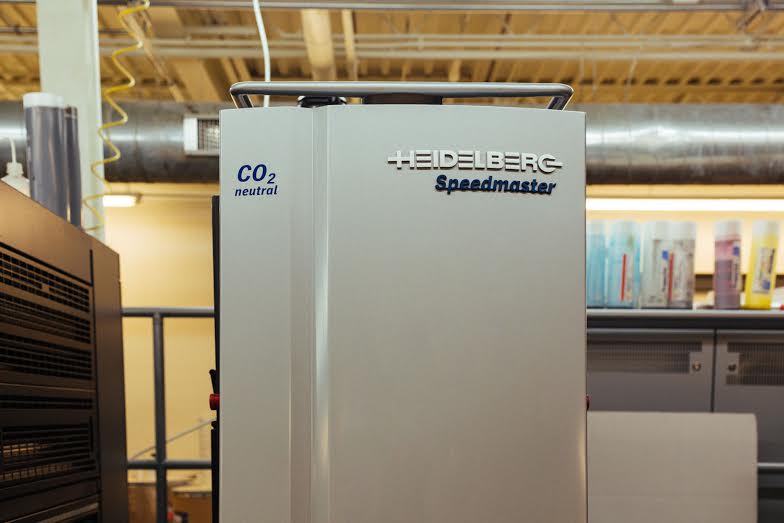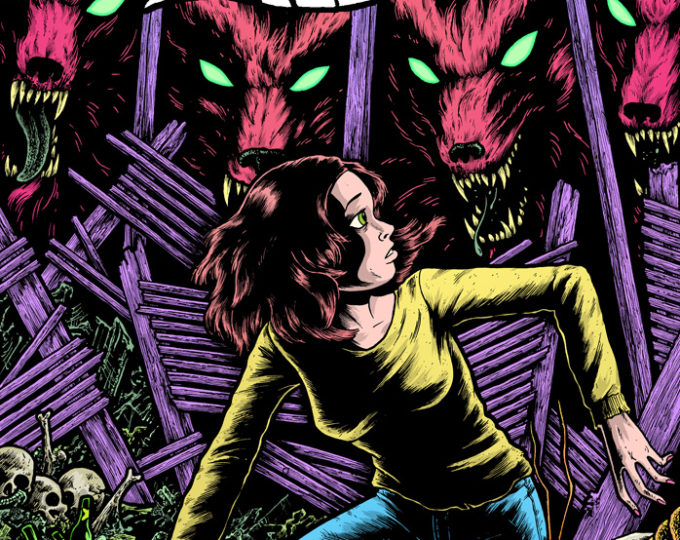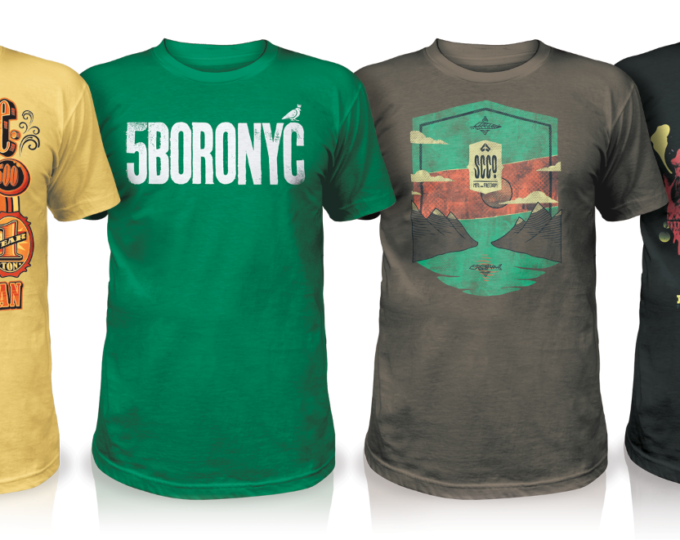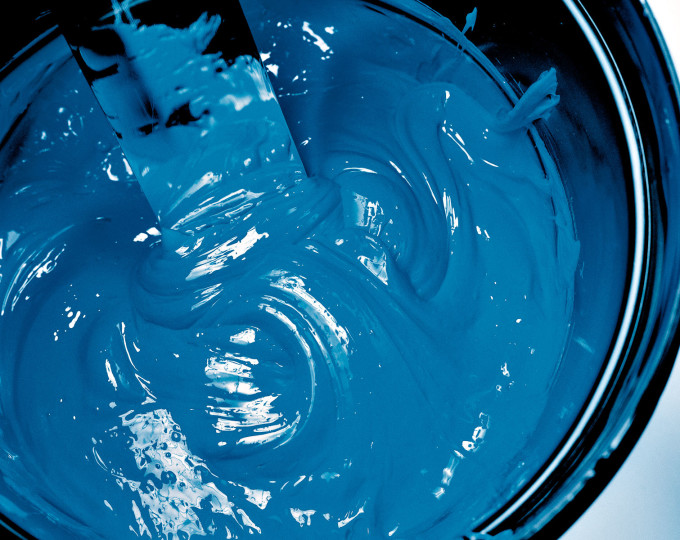Printing Sustainably Doesn’t Need to Be Hard or Expensive
Historically, print has been a dirty business: colorful, chemical-laden goo smeared on top of dead trees. While most print businesses use all the right buzzwords, their claims often lack substance. Or, even worse, we’re fed the Whole Foods model — that the only sustainable options are expensive and luxurious. The best thing most designers could do, if they were truly committed to the environment, would be to avoid print. Go digital, it’s the only way to be sure, right? Wrong.
We sat down with some of the best and brightest Jakprints employees, LT Magnotto & Jeff Wisenberg, to talk about the ins and outs of screen printing.

LT has worked in color separation at Jakprints for more than a decade and is considered one of the best in the industry.
Color separation is the process of breaking down a full color image into a few colors so that it can be screen printed without the eye seeing the limited number of colors.

Jeff has the honor of being the very first employee of Jakprints. He’s put in 16 years of hard work to help build the foundation of what we have today. Jeff is the head of apparel production, making sure they have everything they need in order to make the best possible product.
Tips for Screen Printing
Some designs work better for screen printing than others but, as LT says, “Everything works, we won’t turn any projects away.”
Streetwear is one of the most self-expressive forms of popular fashion. Bright colors and bold designs make streetwear apparel some of the most interesting pieces on the market today.
Starting in California in the early ’80s, the DIY graffiti look spread from California like wildfire into other subcultures. It was evident in punk style in the Midwest, Harlem’s budding hip hop culture and, on the other side of the world, becoming the epitome of fashion in Japan.
Since the very beginning, hats have been an essential part of streetwear and have become synonymous with the culture. Get inspired by the stories of these iconic and upcoming streetwear brands and the hat styles they have helped propel into the spotlight.

Yupoong One Ten Snapback
All over the world, people are striving to be better to the environment. We’re driving less, creating less waste and cutting down on our energy usage.
As printers, we’re very aware of our potential impact on the environment. That’s why we pride ourselves on being good environmental stewards by practicing the most eco-friendly printing practices available to us, from our print stocks to our production floor.

With the help of Trees for the Future, we plant one tree with every order placed with us. Find out more about them down below.
This glossary defines all of those green buzzwords that get thrown around when people talk about “going green”. At Jakprints, these are more than buzzwords, they’re the way we run our business. We hope this helps you better understand green printing and, if you have any more questions about green printing or what we do here at Jakprints, give us a call!
Terms
Biodegradable – This refers to a substance or object that can be decomposed by bacteria or other living organisms.
Carbon Neutral – Making no net release of carbon dioxide to the atmosphere, meaning a zero carbon footprint. This is done either by having no carbon emissions or by offsetting your carbon emissions with carbon credits.
 Our Heidelberg Speedmaster Printer is completely Carbon Neutral
Our Heidelberg Speedmaster Printer is completely Carbon Neutral
Chain of custody – The path that goods (raw materials, processed materials and products) take from the forest to the consumer, including all stages of processing, transformation, manufacturing and distribution.
Responsibly Forested – This refers to paper that comes from well-managed forests located in North America or Europe and is certified by one of the three major organizations who follow the trees, pulp and paper through the entire chain of custody.
Post-Consumer Waste – This refers to products that are made with recycled waste but not always traditionally recycled materials.
Waterless Printing – Waterless printing is an offset lithographic printing process that uses no water unlike conventional printing. It uses silicone rubber coated printing plates and specially formulated inks. Typically a temperature-control system is integrated into waterless presses.
V.O.C – Volatile organic compounds organic chemicals that have a high vapor pressure at ordinary room temperature. They have harmful effects on humans, animals and the environment after prolonged exposure.
Inks & Paper Stocks
BIOflex – BIOflex is a custom material that when in landfill conditions (darkness, high heat, moisture and oxygen deprived) attracts microbes that break down the PVC within 3 to 5 years. BIOflex contains no toxic materials and is tear, fade and fungus resistant.
Carbon Credits – Sometimes referred to as Carbon Credit, is a financial incentive awarded to businesses for every tonne of Carbon Dioxide removed or reduced during the production of their products. They can be earned by planting trees, using renewable energy and energy efficiency projects.
Petroleum Inks – Petroleum-based inks are more expensive than soy-based inks and release a large amount of VOCs including toluene, benzene and xylene. These compounds can be very harmful to the environment, wildlife and people.
Vegetable Based Inks – Vegetable oil based inks are derived from renewable resources, most commonly soy. They are also easier to recycle than petroleum based inks. As opposed to traditional petroleum-based ink, soy-based ink is more environmentally friendly, it provides bright, vibrant colors.
Water Based Ink – These inks soak into the fabric instead of sitting on top like traditional inks. The provide a soft to the touch feel and a vintage, faded look. These are some of the most environmentally friendly inks available.

Water based ink gives this tee a vintage feel
Environmental Advocacy Groups
FSC – This stands for Forest Stewardship Council. An FSC certification ensures that products come from responsibly managed forests that provide environmental, social and economic benefits.
PEFC – Program for the Endorsement of Forest Certification is the world’s largest and only entirely not-for-profit global forest certification system.
SFI – Sustainable Forest Initiative Inc. is an independent, nonprofit organization that is solely responsible for maintaining, overseeing and improving the internationally recognized Sustainable Forestry Initiative® program.
Trees for the Future – Trees for the Future is a non-profit organization based in Maryland that helps rural communities in Africa, Asia and Latin America replenish forests destroyed by floods, droughts and unsustainable farming practices. These efforts not only improve the environment but the quality of life for hundreds of communities.

Combined with colored paper stocks, white ink is one of the coolest ways to take your designs in a new direction. Use this fifth color to create truly unique designs and effects.
But, unless you’re used to using white ink, some of these techniques might seem a bit illusive. Fear not! We’ve got some great examples of white ink being used in designs and some insights about how to use it.
If you’ve already created a white ink design, pop over to our tutorial on how to set up your Adobe Photoshop and Illustrator files for printing.
To get a firsthand view into how designers are leveraging white ink, we sat down with designer and illustrator Nick Matej of downtimecollective.com.
White As A Fifth Color

Embroidery is a unique and creative way to add special details to all kinds of apparel and accessories! With unique threads and effects to enhance designs, embroidery is becoming more and more popular. Here are some artists and designers who are trying new ways to use embroidery in their work:
 1. Designer Fitted Hawaii worked with New Era to create these printed 5 Panel hats. The embroidery uses silver metallic, as well as solid colored thread, to create the shark design. They aren’t the only brand featuring them, 5 Panel hats are major staples for today’s hottest designers.
1. Designer Fitted Hawaii worked with New Era to create these printed 5 Panel hats. The embroidery uses silver metallic, as well as solid colored thread, to create the shark design. They aren’t the only brand featuring them, 5 Panel hats are major staples for today’s hottest designers.
Screen printed posters are some of the coolest promotional and collectible pieces bands and brands can make. Musicians, take advantage of one of a kind art your fans will want to collect. Brands, benefit from eye catching art that promotes your message while giving consumers something more than plain old advertisements to look at. You can use screen printed posters to elevate your brand by creating art instead of standard promo flyers.
Here are 10 artists that use screen printing to create stunning original artwork as well as art to promoting bands, events, businesses.
 1. BLDG teamed with the City of Covington to advertise their Food Truck Invasion event. They also took this opportunity to promote the city’s brand as a destination for art, culture and entertainment.
1. BLDG teamed with the City of Covington to advertise their Food Truck Invasion event. They also took this opportunity to promote the city’s brand as a destination for art, culture and entertainment.
Stop the presses! No, really. Stop them. The future of eco friendly printing has arrived! Jakprints has teamed with Heidelberg USA to bring the Speedmaster XL 75 Anicolor press to Cleveland. It’s the very first of its kind in North America!
Our new Heidelberg press is a massive jolt to the printing business thanks to its efficiency, versatility and environmental friendliness.
The Speedmaster XL 75 Anicolor cuts down paper waste by nearly 90%, reducing waste to between 1.6 million and 2.4 million press sheets per year. On average, we’ll be saving 16 trees a day!
For years you’ve been lugging around a composition notebook, maybe that’s what you used in college to keep all your ideas and designs in. It’s an old favorite but maybe not completely practical for ideas that come to you while you’re on the go. What you need is something smaller, pocket sized. There are small notebook options out there but many make you skimp on quality or customization, which isn’t what you need when you’re looking for a creative outlet.
Pocket Notes have 48 pages of unabashed creative space with a completely unbranded cover! Printed with pristine quality and full color, these tiny notebooks will turn heads at trade shows or provide your employees some unity around the office.
Completely Unbranded Cover?
Yes! Other brands offering pocket sized notebooks put their name all over them. These notebooks are completely blank so you can put whatever you want on them without needing to work around someone else’s logo.

Choose from one of the 5 cover stocks to completely customize your Pocket Note. Maybe an edgy black with a bold design or kraft stock for a more rustic look:
- 100# Gloss – light-weight medium gloss
- 12 pt Gloss – standard-weight gloss
- 100# Kraft – natural colored paper
- 100# Black – medium-weight stock paper
- 110# Pearlescent – medium-weight card stock with a pearly sheen
Covers can be printed single or double sided for our colored stocks, 5th color white comes standard so don’t worry about muddy or faded images. For the best results, we suggest you use our templates to make sure your art prints just the way you want it to.
Fashion trends come and go but baseball hats have woven themselves into the American identity like the braided crust atop an apple pie. Each year, more than 43 million baseball hats are sold in the US. Of those, only about 2,000 go to actual MLB players.
It’s obvious they aren’t going anywhere so it’s worth brushing up on your history. This is the working man’s guide to the ever expanding world of Baseball Hats – including a quick history, their evolution from on field necessity to off field fashion trend and how to properly size a hat for your noggin.
An Abridged History of MLB Baseball Caps
Way back in the mid-1800’s, when Baseball was in it’s infancy, the rules about head wear were non-existent (unlike today when it seems like there’s a rule or regulation for everything). Officials cared so little, the first official Baseball team, The Knickerbockers, wore straw hats, boating caps, jockey caps — whatever they wanted to block the sun.





